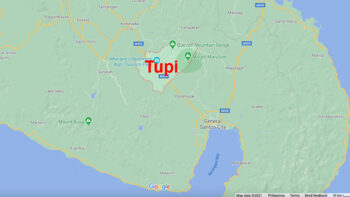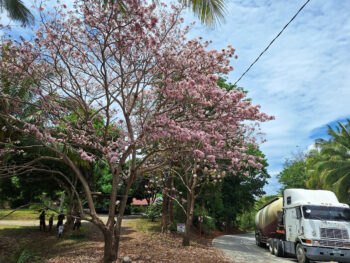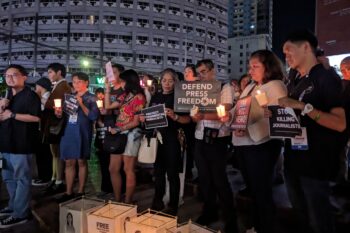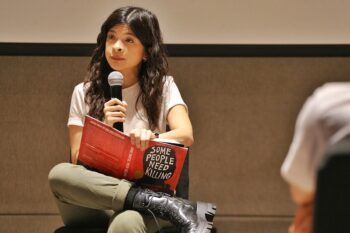PASAY CITY (MindaNews/22 December) – First of all, we would like to pray for the repose of the soul of the late Abdulmari Imao; that he may have the safe journey into the Highest Realm; that he may be guided with the cardinal doctrine that Allah (SWT) is his God; that Nabi Muhammad (SAW) is his Prophet; and that the Holy Qur’an is his sacred scripture; that the Day of Judgment is a reality; that death is a reality; and that he is due for the alamu l-barzakh, the isthmus or the bridge between this dunya or this world and the Hereafter.
Today, we witness the necrology of the late Abdulmari Imao. It is an occasion for that humble man who has already gone ahead to face the Lord. It is an occasion, too, for the living to reflect with the fact that all of us – sons and daughters of Adam (AS) – will also experience death and to pass through it.
The Holy Qur’an says: “Each soul shall have a taste of death.”
As death is thus inevitable, we all have to prepare always for the new and eternal life to come, just as we have to learn lesson (ibra) about the reality of our lives, even their most minute details, how insignificant they may be.
Incidentally, the life story of the man we witness today is as significant not only for himself and his family, but for us the living and for the nation as well – a nation that purports to grant him a fitting recognition.
It is more than a feat, to the say the least, for a poor boy from the Sulu Archipelago to be able to inspire the Filipino people and the Muslims in the Philippines for decades and the years to come due to his unique art works meriting him many awards since the 1960s including the prestigious National Artist Award granted to him in 2006.
Whereas many of his contemporaries in the South honed their acumen and skills in politics, business, and education, even as few of them embraced armed struggle, Abdulmari Imao took the brush instead and swayed his hands over the canvas, molded clays and brassware; while taking inspiration from spatial connection and timeless representation of the ukkil or okir and the unity and diversity symbolism of mythical sarimanok, and the grand and fearless depiction of naga or dragon, to name three of his favorite Moro art motifs.
Abdulmari, known to his friend as Abdul or Mari, must have not chosen casually these three art motifs. These must have been taken as an overarching reference not only for his artwork but as symbolism of his culture and tradition including his belief and worldview.
I am quite unfortunate for not having known him personally and intimately. I relish though, like others, his artworks.
As an artist, Abdulmari reveals the glare of ukkil, sarimanok and naga in his painting and sculpture while showing the rich cultural and artistic tradition of the Moros within the frame of cultural pluralist setting in the country. This must be the obvious, the exterior dimension, and the basis with which many of us appreciate him and his art legacies.
There is yet another frame with which to fully understand or appreciate Imao’s work. Especially to a connoisseur of arts with spiritual and mystical orientation, it can be safely said that Abdulmari’s artworks crystallize the universal principles of life and the inherent unity of creation and the eternal quest, the bravery of man and woman to struggle and to reach the Highest Truth.
This varied prism in looking at Imao’s work augurs well especially in today’s increasing disunity and division of humanity, mechanization of global culture, superficial appreciation of symbols, and massive trend of exclusion and exteriorization. All of these need a counter-prism like Imao’s artworks that represent and envision unity, harmony, courage, and so on.
Abdulmari must have never dreamt early in his life to become a national artist. Like other real artists, Imao’s satisfaction must be in the moment he captures his imagination with his hand to produce his works like his magnum opus many of which are displayed in many parts of the country – from the Capitol building of the Sulu Provincial Government in Jolo to the “Allah” calligraphic sculpture at the Vargas Museum in UP Diliman.
The State is thus grateful for Imao for his artistic depiction of Muslim cultural symbols and the values they evoke like unity, beauty, courage, and spiritedness – values that are very much needed by the nation today.
Beyond such recognition, there is thus a deeper yet universal message that pervades in Imao’s art works and what they truly represent.
The art motif of ukkil represents the inherent connectedness of life, the yin and the yang, the positive and the negative, interacting endlessly in a spatial time, in a timeless space.
The mythical sarimanok is a famous representation of unity and diversity, the harmony of jalal (majesty) and jamal (beauty), the major categories of asmau l-husna or the Divine Names of Allah (SWT).
In the classic work of Fariuddin Attar’s “Mantiqu t-tayr” (Conference of the Bird), birds particularly the anqa or the Simurgh represent man’s longing or quest to know the Highest Truth or the Divine; whereas the naga or dragon symbolizes courage and fearlessness in the whole quest or journey.
If life’s unity and spiritual quest best represents Imao’s work of arts even if possibly our artist is not vocal or unconscious about them, then it is imperative for us to be grateful to him for capturing vividly what life really is and its processes.
For, all of us share such notion of life and the journey that our artist has now undergone even as all of us will have to follow him sooner or later.
The Holy Qur’an says: “How can ye reject the faith in God – seeing that ye were without life, and He gave you life; then He will cause you to die; and will again bring you to life, and again to Him will ye return.”
Our artist has already treaded to the third stage of life; we, the living, are in the second stage. One cannot stay in one stage forever or leap forward beyond schedule. The key is preparation. And the foundation of preparation is belief.
To believe is not necessarily to abandon the world. It is to live in state of balance and moderation. There is a hadith (saying) of Prophet Muhammad (SAW) that says more or less: “Work for your life in this world as if you will live forever, but work for your Hereafter as if you will die tomorrow.”
The Holy Qur’an provides a guarantee to believers with their soul in journey when it says: “Wa laa takhaafu wa laa takhzanu.” And do not be afraid nor be sad.
A reading from the Holy Qur’an (Surah Yasin)…
[MindaViews is opinion section of MindaNews. A necrological prayer delivered during the Pagdalamhati ng Bayan, Abdulmari Asia Imao, Pambansang Alagad ng Sining para sa Sining Biswal, Tanghalang Nicanor Abelardo, Sentrong Pangkultura ng Pilipinas, 21 December, 2014. Julkipli Wadi is Associate Professor of Islamic Studies, University of the Philippines].







